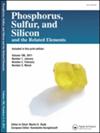Deprotonation of diphenylsilane with organosilyllithium agents
IF 1.4
4区 化学
Q4 CHEMISTRY, INORGANIC & NUCLEAR
Phosphorus, Sulfur, and Silicon and the Related Elements
Pub Date : 2025-01-02
DOI:10.1080/10426507.2024.2444666
引用次数: 0
Abstract
Although there are many reports on deprotonation of carbon analogues, there are only a few reports on deprotonation from silanes. This is because the lone pair of a base mainly attacks hydrogen of a C–H bond and deprotonates, whereas in the case of silanes, the base is added to the silicon atom of a Si–H bond. Previous reports have shown that deprotonation from silanes requires the assistance of negative hyperconjugation by silyl substituents or intramolecular chelating groups (pincer ligands). We proposed that lithium and hydrogen exchange approach could be applied to the deprotonation of monosilanes using bulky silyllithium instead of some bulky strong bases, such as t-butyllithium and LDA. Here, we report the first successful approach to the deprotonation of monosilanes without intramolecular chelation.
有机硅锂试剂对二苯基硅烷的脱质子反应
虽然关于碳类似物去质子化的报道很多,但是关于硅烷去质子化的报道很少。这是因为碱的孤对主要攻击C-H键的氢并去质子化,而在硅烷的情况下,碱被添加到Si-H键的硅原子上。以前的报道表明,硅烷的去质子化需要硅基取代基或分子内螯合基团(钳形配体)的负超偶联的帮助。我们提出锂氢交换法可以应用于单硅烷的去质子化,用大块的硅锂代替一些大块的强碱,如t-丁基锂和LDA。在这里,我们报告了第一个成功的方法去质子化的单硅烷没有分子内螯合。
本文章由计算机程序翻译,如有差异,请以英文原文为准。
求助全文
约1分钟内获得全文
求助全文
来源期刊
CiteScore
2.60
自引率
7.70%
发文量
103
审稿时长
2.1 months
期刊介绍:
Phosphorus, Sulfur, and Silicon and the Related Elements is a monthly publication intended to disseminate current trends and novel methods to those working in the broad and interdisciplinary field of heteroatom chemistry.

 求助内容:
求助内容: 应助结果提醒方式:
应助结果提醒方式:


